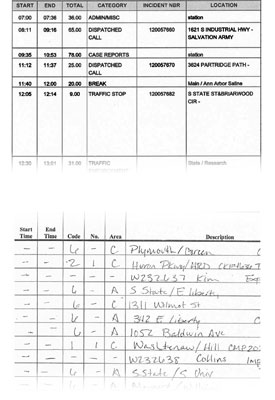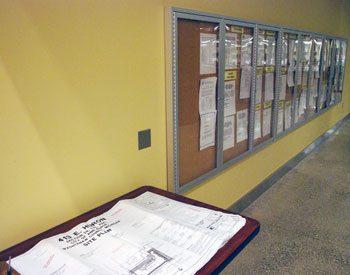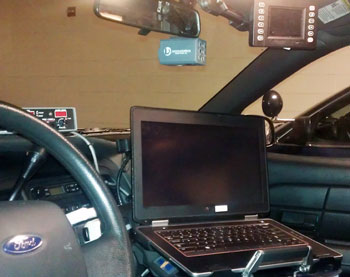Column: When Tech Supports Policy Decisions
When the Center for Digital Government’s Digital Cities Survey ranked Ann Arbor as first in its population category for 2012, I considered this to be terrible news.

Ann Arbor police department old-style, manual officer activity reports (bottom) contrasted with a newer-style, digital records system.
It deprived me of my favorite way give a poke in the ribs to Dan Rainey, who heads up the city’s IT department: “A top 10 finish, huh? So what went wrong? Why not first place?”
Of course, a top ranking on the Digital Cities Survey is not a terrible thing. And by rights, as part of the Dec. 3, 2012 city council meeting report, Chronicle readers might have reasonably expected to see some mention of that first-place award.
That was the meeting when Rainey announced the award, and invited IT staff to the podium to talk about some projects they’ve been working on. Those included a project involving traffic and signal systems that’s connected to the University of Michigan Transportation Research Institute’s smart-vehicle research study. They also talked about a project that will integrate three major software systems at the city: asset management, finance and payroll.
None of that award talk made it into the Dec. 3 meeting report.
Last year, when the merely fifth place Digital Cities ranking was announced, it was also not included in The Chronicle’s council meeting report. As a partial explanation for that omission, I wrote in a subsequent column: “But one reason I don’t mind omitting that kind of award from a meeting report is that it really does not matter to me where Ann Arbor ranks on that survey. What matters to me is the fact that the city’s investments in the realm of digital technology make life in Ann Arbor as a local journalist easier than it would be otherwise.”
That column put a spotlight on some of the city’s digital tools I use on a regular basis that make my life as a journalist easier. This year, I’d like to highlight three digital projects that I think will make life easier and better for citizens and policymakers, too. None of these three projects were mentioned at the Dec. 3 meeting – which is to say that I stumbled across them in my regular travels.
Those three projects are: (1) the transition to a digital platform for submitting site plans to the planning and development department; (2) the integration of a simple button push that Ann Arbor firefighters can use to record timestamps at key points during their response to calls; and (3) conversion of pen-and-paper police department officer activity reports to a digital format.
It’s the third project I am particularly excited about – because of its potential to provide data that will directly affect policy choices made by the city council. That optimism is based in part on the fact that it was cited specifically at a recent city council planning session. The question it will help answer is this: How much time do Ann Arbor police officers have available for proactive policing?
Plan Submissions
On the north side of the recently renovated city hall lobby stands a folding table laden with sets of drawings that have been submitted to the city’s planning and development department. The table has replaced the more substantial pre-renovation pedestal.

Plans under review sit on a table in the Ann Arbor city hall lobby, next to the glass cases that hold public notices.
Ann Arbor residents who followed every twist and turn of the City Place project’s approval process back in the summer of 2009 might recall that the accessibility of such drawings to the public isn’t just a courtesy, but an ordinance requirement.
In the course of that project’s approval process, it was questioned whether conformance had been achieved with the ordinance, which required that the drawings be kept up to date as revisions were made. As a result, City Place was sent back to the planning commission for re-review, just as the city council was poised to vote on it. Subsequently, on July 6, 2010, the city council revised the ordinance, so that the plans and drawings in the lobby needed to be current only at the time of placement. Subsequent revisions are available in the planning offices, according to the amended ordinance.
During deliberations on the initial approval of that ordinance change, on June 21, 2010, the idea of using digital technology to solve the problem was floated. From Chronicle coverage of that meeting:
[Councilmember Sabra] Briere wondered why more time had not been invested in coming up with something more cutting edge, instead of just adding a restriction. [Planning manager Wendy] Rampson said she believed that the lobby display of plans had become somewhat outdated – up until a few years ago, it was the only way to see the plans. But now, she said, all the plans are included as .pdf files as a part of the Legistar system available on the web. So for those who have computers, they can access the information that way. For those who don’t have computers, the public library has public computers available, she said.
If that ordinance change two and a half years ago could be considered a step backward for public accessibility to planning documents, then city council action a few weeks ago, on Dec. 17, 2012, could be considered a step forward. The council approved a $61,000 contract with CRW Systems Inc. in a total project budget of $90,000 for implementing a digital system to submit plans to the city’s planning and development department.
The council’s conversation that night focused on the cost savings for those submitting plans and time savings for staff – who could make comments on a single set of drawings without needing to transcribe the same comments onto a second set. But in the staff memo was a note that the budget includes a kiosk for public viewing of documents. That means the lobby access point for the documents can provide the most up-to-date version to those who use it.
Responding to an emailed query from The Chronicle, city planning manager Wendy Rampson indicated that while no specific hardware had been identified yet, the intent was to replace the table and paper drawings with a kiosk. She wrote: “It might actually turn out to be a flat screen, rather than a traditional kiosk.”
Fire Department Timestamps
A second digital initiative not mentioned during the Dec. 3 Digital Cities presentation was the deployment of software and hardware made by ADASHI. The new technology will allow Ann Arbor firefighters responding to calls to record key time points in their responses.
Instead of radioing Huron Valley Ambulance dispatchers that they are leaving the station, and having the HVA dispatchers log the time, firefighters can simply push a button on their firetruck console that will record that timestamp. And when they arrive on scene, another button-push records the firefighter arrival time into the system.
Recording these time intervals accurately is crucial to evaluating how well our fire protection system is meeting national standards for key intervals: call processing time (from the 911 call to the point when the alarm is sent), turnout time (from the alarm time to the time the truck leaves the station) and travel time (from the fire station to the scene).
Radioed communication between firefighters and HVA dispatchers has not always resulted in accurate times being recorded into the computer-aided dispatch system – based on records The Chronicle has reviewed and reported on previously.
And a clear picture of response times – that everyone can agree actually depicts the activity of dispatchers and firefighters during their response to emergency calls – is crucial for evaluating the adequacy of staffing and the deployment of those staff to different fire stations. [See previous Chronicle coverage: "A Closer Look at Ann Arbor's Fire Station Plan."]
One piece of the ADASHI implementation that was reportedly still having some wrinkles ironed out in mid-December was the automatic transfer of the timestamps into official fire department reports.
Once those wrinkles are ironed out, I think this time-stamping system will be a benefit to firefighters and residents alike.
Police Officer Activity Reports
Also related to public safety is the Ann Arbor police department’s implementation in 2013 of a digital, database-driven approach to officer activity reports. Previously, officers recorded their activity manually, with pen and paper.

Interior of Ann Arbor police patrol car with the computer hardware they’ve been equipped with for many years. The new activity reports will be logged using this hardware. (Photo by AAPD)
The image included at the top of this column shows the contrast between the two kinds of reports. For readers who’d like to look at contrasting samples in more detail, here’s a manual log compared to the digital version: [.pdf of pen-and-paper officer activity report] [.pdf of digital officer activity report]
The advantage of the digital reports is not just that they’re neater. More importantly, they allow for easy tracking of how our Ann Arbor police officers are spending their time.
It’s not important to know, for example, that Officer X, on one shift, had 24% of his time unassigned and that on another shift 32% of his time was unassigned. But over the course of the next year, if officers generally have between 25-30% of their time available for proactive policing and community engagement, then that’s part of what public safety success looks like – as defined by the Ann Arbor city council at a recent planning session.
At that planning session, the council achieved a consensus that the public safety policing priority should be defined this way:
Public Safety (Final Version): Police
What is the problem we are solving? There’s inadequate police staffing resources to do proactive and consistent enforcement and community outreach.
What does success look like? The success statement has three parts:
- Part 1 crime rates (major crimes) show Ann Arbor is among the safest 20% in the country.
- The community perception of safety is high.
- Police officers have between 25-30% of their time available for proactive policing.
This definition of the priority – together with easily accessible data about how officers spend their time – could allow city councilmembers to break out of the fairly unproductive conversational pattern that has repeated itself over the last several years:
A: We have way fewer police officers than before. We need to hire more of them.
B: But crime is down. We don’t need more police officers.
A: Why don’t you care about public safety?
B: I care as much as the next guy.
A: But not as much as I do.
We have the potential to replace that pattern with one that could go like this:
A: Our police officers on average have only 24% of their time available for proactive policing and community engagement. I want to hire two more officers.
B: But we’re within 1 point of our goal. Do we really want to consider that falling short of our goal?
A: Are you asking if 24 is less than 25? Yes, it is. So let’s hire two more officers.
B: Okay, I’m willing to acknowledge the need to hire additional officers to meet our proactive policing target. But I don’t think we have the money this year to do it.
A: That’s where we disagree, then. I’m voting to add to police officers.
This second kind of conversation is one that I think is more productive and fruitful than one that makes staffing levels a proxy for the actual issue we should focus on: Do current staffing levels allow police officers to do the things we want them to be able to do?
The new reports don’t just allow us to discern how much time is available for proactive policing. They allow an analysis of very specific kinds of activities. For example, when dedicated downtown patrols were eliminated a few years ago – in favor of officers occasionally swinging through downtown, parking their patrol cars and using their out-of-car time to walk downtown – some merchants were skeptical. Now it should be possible to measure easily how much time officers are spending on these impromptu downtown foot patrols.
Any conversation about downtown foot patrols can be based on arguments about how well the current strategy is actually working. What’s the average total time spent policing downtown on foot? What hours of the day is that covering? That strikes me as a more productive way to talk about policing than one that never moves past the sentimental: I really miss seeing the bicycle-mounted cops downtown – why can’t we bring them back?
Responding to a query from The Chronicle, IT manager Dan Rainey explained that the digital officer activity reports stemmed from work being done in the Washtenaw County sheriff’s office. And through collaboration with the city and the county, the system was presented to CLEMIS (Courts and Law Enforcement Management Information System), a multi-jurisdictional consortium for southeast Michigan managed by Oakland County. The system is being piloted by three agencies, and on completion of the pilot, the more than 80 other policing agencies that are members of CLEMIS will be able to use the system.
Parting Thoughts
I expect that for 2013, the city of Ann Arbor will again rank highly on the Digital Cities Survey. And it will again be announced at a city council meeting. And I look forward to not including that announcement in The Chronicle’s meeting report, so that I’ll have an excuse to write something longer about the city’s digital technology initiatives.
And if the ranking is second place, instead of first place, I also look forward to asking Dan Rainey: So what have you been doing wrong that are we are now slipping?
The Chronicle could not survive without regular voluntary subscriptions to support our coverage of public bodies like the Ann Arbor city council. Click this link for details: Subscribe to The Chronicle. And if you’re already supporting us, please encourage your friends, neighbors and colleagues to help support The Chronicle, too!




I’ll be interested to see how much of police officers time is spent accounting for their time.
I guess I thought plans were already being submitted electronically. If not, where do the PDFs come from? Are staff scanning in the paper?
I think a kiosk would be great. While I loved the pedestal, I find it hard to find the project I want out of the stack, and moving from one page to another is not easy. I do hope the kiosk would have a screen at least as big as the sheets of paper we have now, and an easy to use navigation system.
Congratulations to the City of Ann Arbor received for the number 1 status in the Digital Cities Survey. It comes as a result of a lot of hard work, most of which is done in the background. And even when this hard work comes to the surface it is greeted “ho hum” by the media. Washtenaw County has been in the top 10 for 8 out of 9 years (sometimes high, sometimes lower). Ho hum. In a way, this is as it should be, since IT isn’t the work or the information, it just makes the work and information easier or more accessible. I appreciate the Chronicle’s occasional pieces that highlight how technology makes journalism easier or more informed – how you can spend more time analyzing and less time digging. It lets us know when we are on the right track and also gives us some nudges on things we ought to do.
I’ve admired Washtenaw County’s website for years. Not just because I used to be on the BOC (I had nothing to do with it) but because it has always seemed to be supremely logical and accessible. Thanks to Andy and his co-workers.
I wish the same could be said for Ann Arbor’s website. Regardless of the award, the user interface has many problems, which I will not go into here.